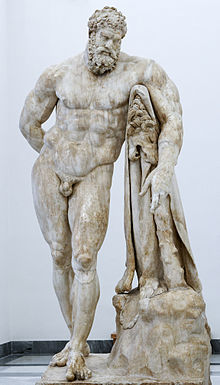Farnese Hercules
The Hercules Farnese (also Hercules Farnese , Herakles Farnese or the Farnesian Hercules ) is an ancient sculpture. It was named after the subject of its depiction, the ancient demigod and hero Hercules , and the place where the statue was displayed as a collection item in modern times, the Farnese Collection . It is now on display in the National Archaeological Museum in Naples . More than 200 large and small format replicas and variations of the “Hercules Farnese” from Roman times attest to the fame the statue had in antiquity.
Description and assignment
The statue shows Heracles resting after his heroic deeds, in his left armpit leaning on his club, which is set up on a rock, above the skin of the Nemean lion . His right arm is bent backwards, the right hand lies behind his back and holds the three apples that Heracles won at the Hesperides . The body is extremely muscular, the hero is depicted as a bull-necked figure. The head is disproportionately small in relation to the massive body. His gaze is lowered to his left.
Herakles steps fully with both feet, the right standing leg is set back slightly, the left free leg slightly forward. The leg position chiastically contrasts the arm posture and enables an extraordinarily expansive effect and twisting of the individual body parts for a resting figure. The classic contraposto , as embodied most perfectly in Polyklet's work , has largely been dissolved: the free leg is set forward, the head is turned to the side of the free leg, the body axis is shifted from the center. However, none of this is new either. One around 360 BC The statue of Heracles in the Ny Carlsberg Glyptotek in Copenhagen already shows all the beginnings of the compositional scheme, albeit in a much less dramatic version leading to the art of Hellenism .
Archaeologists agree that the original of Hercules Farnese is attributed to the sculptor Lysipp . Strabo reports that a very large Lysippian statue of Heracles was found by Fabius Maximus after the city was taken in 209 BC. BC from Taranto to Rome and was placed on the Capitol. Lysipp created around 320 BC His colossal figure, almost three meters tall, whose bronze original has been lost. A Roman copy by the sculptor Glykon has been preserved .
Discovery and further fate
The copy of the glycon, which was presumably made especially for the Baths of Caracalla in Rome, which was inaugurated in 216 AD , was found there in 1546. At first only the torso was discovered. The head was found in Trastevere , and excavations in the thermal baths uncovered the legs that had been lost until then, but were not immediately adjusted, as the additions made by Guglielmo della Porta , a pupil of Michelangelo , were found to be so appropriate that they were considered Evidence of one's own skill at the time left on the statue. Pope Paul III had the two colossal figures set up in the courtyard loggia of the Palazzo Farnese . It was not until 1787, when the statue came to Naples, that the legs and torso were brought together.
The figure became an attraction for visitors. Landgrave Karl von Hessen-Kassel saw her during his trip to Italy in 1699/1700 in search of inspiration for the design of the royal seat of Kassel . The landgrave had a large garden built to the west of the city of Kassel. To top it off, the " Kassel Hercules ", an 8.25 m high copy of the "Hercules Farnese" made of copper , has been looking down from the summit of the Karlsberg since 1717 . Goethe mentions the "Hercules Farnese" in his Italian trip (1786/88). At that time the King of Naples had the "Hercules Farnese" set up in his residence. Soon after, Napoleon wanted to have the statue brought to France because it was missing from his newly created collection. In 1799 it was already packed and only the revolution in Naples prevented its removal. Numerous replicas from the 16th to 18th centuries have been installed in Europe's parks and gardens.
Another antique version of almost identical size was found in Rome in 1566 and acquired by Grand Duke Cosimo I de 'Medici in 1568 . In this example, the head was replaced by a portrait of Emperor Commodus in ancient times , but the statue was distinguished for antiquarians and collectors by a signature of the sculptor Lysipp (now recognized as a subsequent addition) and thus by its supposed authenticity. This version has been in the courtyard of the Palazzo Pitti in Florence since the late 16th century .
Individual evidence
- ↑ Object entry for Hercules Farnese in the Arachne archaeological database ; Mette Moltesen: Catalog of Imperial Rome II: Statues. Ny Carlsberg Glyptotek, Copenhagen 2002, p. 227 no.68.
- ↑ Strabon 6, 3, 1; compare also Pliny , Naturalis historia 34, 18 and Plutarch , Fabius 22, 6.
- ^ Haskell, Penny: Taste and the Antiquity , p. 229
- ^ Haskell, Penny: Taste and the Antiquity , p. 229
- ↑ Krull 1985, pp. 22-27.
literature
- Francis Haskell, Nicholas Penny: Taste and the Antiquity , New Haven, London 1981 (seventh reprint 2010) ISBN 978-0-300-02913-0 , 229-232 (No. 46).
- Diethelm Krull: Heracles of the Farnese type. Copy-critical investigation of a creation by Lysippus . Frankfurt am Main 1985.
- Wanda lion: the colossal figure of Lysipp. In: Christiane Lukatis, Hans Ottomeyer (Hrsg.), Herkules: Tugendheld und ruler ideal . The Hercules Monument in Kassel-Wilhelmshöhe. Exhibition catalog Kassel. Edition Minerva, Eurasburg 1997, pp. 23-30.
- Rolf Michael Schneider: The Hercules Farnese. In: Luca Giuliani (ed.): Masterpieces of ancient art . Verlag CH Beck, Munich 2005, 136–157

